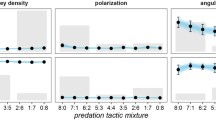Abstract
We present the results of morphology–behavior predator–prey coevolution in a 3D physically simulated environment. The morphology and behaviors of virtual creature predators and prey are evolved using a genetic algorithm and random one-on-one encounters in a shared environment. We analyze the evolutionary dynamics on the basis of quantitative characterization of morphology and behavior. Specifically, we pose and answer the question: which precede the other, morphology or behavior, during the evolutionary acquisition of predator and prey strategies?







Similar content being viewed by others
References
Legreneur P, Laurin M, Bels V (2012) Predator-prey interactions paradigm: a new tool for artificial intelligence. Adapt Behav 20(1):3–9
Agrawal AA (2001) Phenotypic plasticity in the interactions and evolution of species. Science 294(5541):321–326
Edmunds M (1974) Defence in animals: a survey of anti-predator defences. Longman Group Limited, London
Murray J (2003) Mathematical biology I: an introduction. Springer-Verlag, Berlin
Sims K (1994) Evolving virtual creatures. In: Proceedings of the 21st annual conference on computer graphics and interactive techniques (SIGGRAPH 94), SIGGRAPH, Anaheim, p 15–22
Pilat ML, Jacob C (2008) Creature academy: a system for virtual creature evolution. In: Proceedings of the IEEE congress on evolutionary computation, CEC, p 3289–3297
Ito T, Pilat ML, Suzuki R, Arita T (2012) Emergence of defensive strategies based on predator-prey co-evolution in 3D physical simulation. In: Proceedings of the 6th international conference on software computing and intelligent systems, and the 13th International symposium on advanced intelligent systems, SCIS-ISIS, p 890–895
Author information
Authors and Affiliations
Corresponding author
Additional information
This work was presented in part at the 18th International Symposium on Artificial Life and Robotics, Daejeon, Korea, January 30–February 1, 2013.
About this article
Cite this article
Ito, T., Pilat, M.L., Suzuki, R. et al. ALife approach for body-behavior predator–prey coevolution: body first or behavior first?. Artif Life Robotics 18, 36–40 (2013). https://doi.org/10.1007/s10015-013-0096-y
Received:
Accepted:
Published:
Issue Date:
DOI: https://doi.org/10.1007/s10015-013-0096-y




